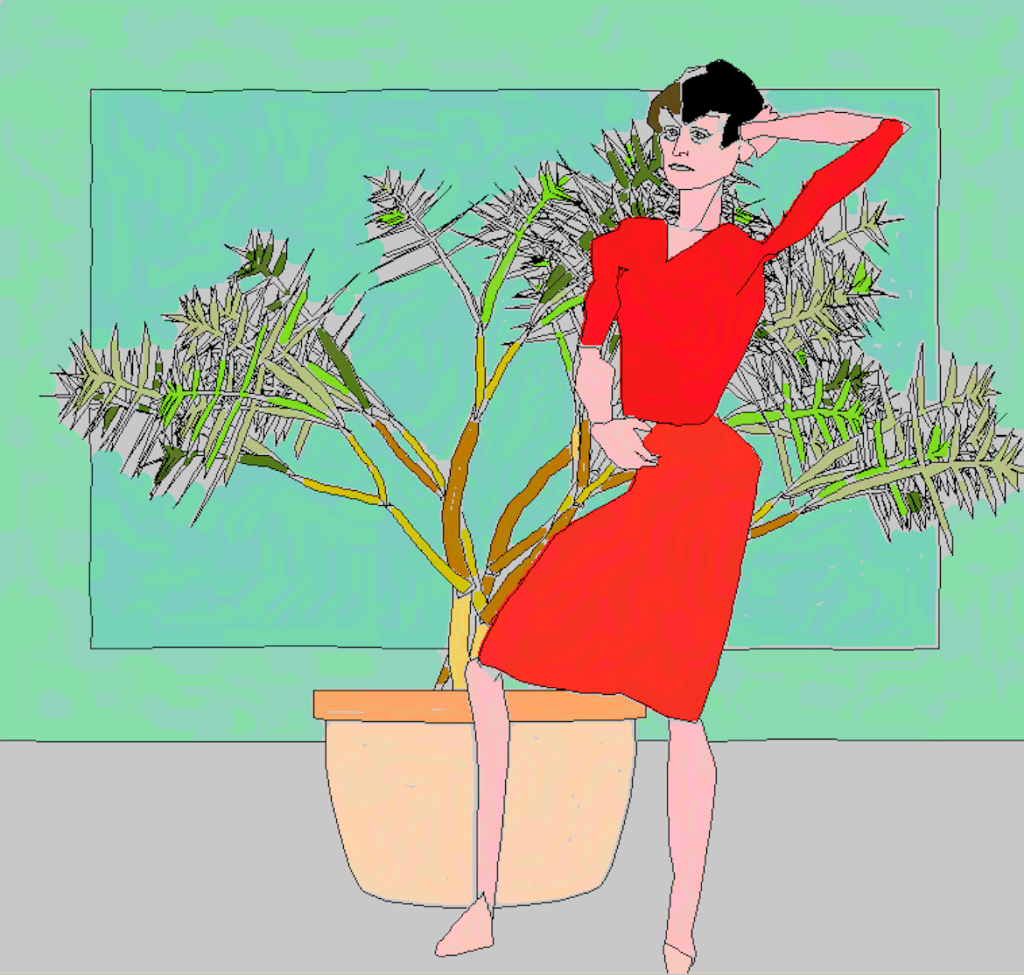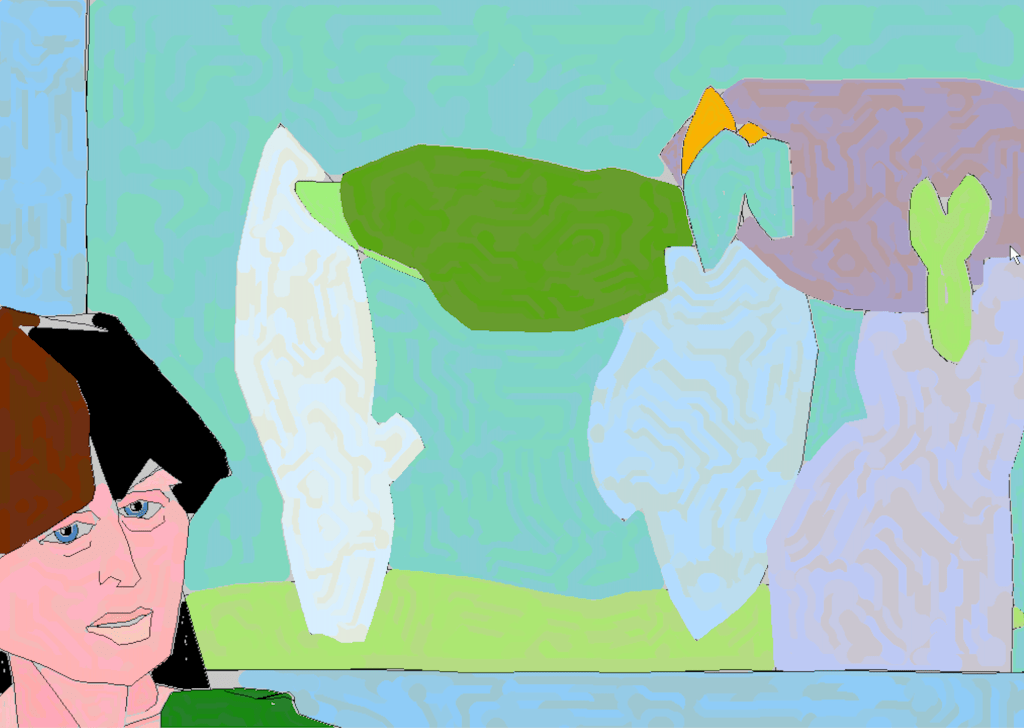Harold Cohen, screenshot from AARON KCAT, 2001. Artificial intelligence software, dimensions variable. Whitney Museum of American Art, New York; purchase, with funds from the Digital Art Committee 2023.20. © Harold Cohen Trust
Harold Cohen: AARON, opening at the Whitney Museum of American Art on February 3, 2024, examines the evolution of AARON, the first AI artmaking program, which was developed in the late 1960s by artist Harold Cohen. Beginning with AARON’s creation and early years, the exhibition explores the foundational stages of AI and its place in art history. In addition to featuring AARON’s drawings and paintings from the Whitney Museum’s collection, the show will highlight the software as the central creative force behind the artworks and demonstrate AARON’s drawing process with pen plotters live in the galleries for the first time since the 1990s. The Whitney is the first and only museum to collect versions of the AARON software from different time periods. Providing an important historical perspective on current AI tools, AARON’s functionality is based on knowledge distilled into rules coded by the artist, which differs from today’s AI image creation tools like DALL-E, Midjourney, and Stable Diffusion, which generate their output from existing images on the basis of a user’s text prompts.
“Harold Cohen’s AARON has iconic status in digital art history, but the recent rise of AI artmaking tools has made it even more relevant. Cohen’s software provides us with a different perspective on image making with AI,” says Christiane Paul, Curator of Digital Art at the Whitney. “What makes AARON so remarkable is that Cohen tried to encode the artistic process and sensibility itself, creating an AI with knowledge of the world that tries to represent it in ever-new freehand line drawings and paintings. Watching AARON’s creations drawn live as they were half a century ago will be a unique experience for viewers.”
Cohen considered creativity a result of dialogue between the program and programmer and viewed AARON as his equal collaborator. The artist built his own pen plotters and painting machines to realize AARON’s outputs in various ways throughout its evolution. In AARON’s early years, Cohen manually added color to black-and-white drawings that AARON made with a pen plotter, generating novel images on paper based on its interpretation of Cohen’s coded commands. Modernized re-creations of Cohen’s early drawing machines, constructed specifically for this exhibition, will be installed in the galleries and draw images from different iterations of the AARON software. There will also be large-scale projections of two versions of the AARON program—one creating figurative outputs, the other generating images of flora.
“At the Whitney, we have a long history and commitment to collecting, exhibiting, and commissioning digital art thanks in large part to the direction of Christiane Paul and our artport platform. By bringing AARON back to life in our galleries, we hope to show how our exhibitions can be as innovative as the artists we present,” says Scott Rothkopf, the Whitney’s Alice Pratt Brown Director. “This exhibition draws from the Museum’s collection to present an important and timely exploration of the early AI tools for artmaking, decades before they entered mainstream conversations.”
Harold Cohen: AARON will be on view through May 2024. This exhibition is organized by Christiane Paul, Curator of Digital Art, with David Lisbon, Curatorial Assistant. The live pen plotting in the galleries will be video streamed. More information about the pen plotting schedule and how to watch will become available on the Museum’s website.


Exhibition Overview – Harold Cohen: AARON
Harold Cohen: AARON examines the practices and experimental programming of artist Harold Cohen, a pioneer in computer-based art. The exhibition looks at the evolution of his AARON software, the earliest artificial intelligence software for artmaking and one of the longest-running contemporary art projects. Fascinated by the computer’s power and potential as an artmaking tool, Cohen devoted his life to pushing the boundaries of AI’s possibilities and understanding what makes an image evocative. Throughout Cohen’s decades-long creative collaboration with AARON, the software underwent iterations that expanded its capabilities. Cohen focused on exploring AI as an instrument that translates artistic knowledge and process into code while creating with autonomy. The artist and his work are a crucial bridge between the worlds of art and engineering.
AARON’s Beginnings
Harold Cohen first conceived his artmaking program at the University of California at San Diego in the late 1960s. From 1973–75, he further developed it at Stanford University’s Artificial Intelligence Lab and named it AARON in 1973. When working through AARON’s development, Cohen drew inspiration from children’s drawing processes, which typically begin with linking shapes and lines before connecting forms to represent an object or person. A 1973 visit to Chalfant Callery, California also influenced Cohen’s thought process. There, he saw prehistoric petroglyphs that furthered his grasp on how a system of marks can translate into an image with meaning. Cohen created AARON as an artmaking tool with the intention of exploring the nature of artistic representation. The program’s name alludes to the biblical figure Aaron, who was anointed speaker and mediator for his brother Moses, much like AARON was Cohen’s collaborator. Cohen’s background as a painter provided him with formal knowledge of artistic principles like color, line, composition, shape, and dimension. He equipped the software with compositional rules and comprehension of artistic paradigms and drawing strategies. For example, Cohen made AARON understand that it must begin drawing in the foreground before moving to the background. Cohen also seeded knowledge of the outside world and specific objects into AARON’s code, which became accessible in the software’s long-term memory. Evolving in several phases, AARON’s proficiency in these knowledge areas became the criteria for measuring the success of the program’s drawings, which were abstract in the early years.
The Figurative Phase
As AARON’s capabilities progressed, Cohen’s code started focusing on figures, often pairing them with plants or flowers in the compositions. Cohen was always striving to expand access to original artworks at a low price for a larger number of people. A reflection of these efforts was the distribution of a screensaver version of AARON, produced in collaboration with computer scientist Raymond Kurzweil’s CyberArt Technologies (KCAT). The KCAT software was released in 2001 and became one of the most widely known versions of AARON’s output.
Fundamentally different from the processes of currently popular AI software, AARON is a procedural system that mimics human decision-making to create images. Today’s AI image creation tools rely on algorithms making associations between images and text descriptions and, based on a user’s text prompts, generate their output from large data sets of existing images. In contrast, AARON determines its output with rules and instructions for completing tasks based on knowledge stored in its memory. Cohen sought to program a painter’s cognitive processes into his algorithms, providing AARON with an understanding of the relationship between line and form within a composition and the ability to imitate an abstract painter’s approach to representation in an image.

Flora and Figures
AARON’s transition from abstraction to figuration in the mid-to-late 1980s signified both a technical and conceptual shift, which required the software to have a different and more tangible understanding of the outside world to create recognizable figures and surrounding scenes.
Cohen’s evolving code advanced AARON’s abilities by adopting strategies from painters’ processes, pushing the program to develop fundamental structures for representing humans. One example of this output on view in the galleries is the painting Untitled, Bathers Series (1986), which alludes to French Post-Impressionist painter Paul Cézanne’s famous paintings of bathers. Featuring rocks and flora alongside abstracted figures that begin to approach human forms, the works from this phase reveal connections to later variations of the AARON software from the 2000s that produced layered foliage environments. The layered plant life in these works eventually transform into complex compositions of foliage in the software from 2007, shown as a projection in the exhibition. AARON, without stored descriptions for specific flora, generates plants based on rules regarding their size, branching levels, and patterns of leaf formation.
About the Artist
Harold Cohen (1928–2016) was a British artist whose innovations at the forefront of technology shaped the field of digital art. Cohen’s artistic practice resulted in his famed creation AARON, the first artificial intelligence software designed to create art independently. After graduating from the Slade School of Fine Art, Cohen had a successful career as a painter, representing the UK at the 1966 Venice Biennale and exhibiting at Documenta III, the Paris Biennale, and the Carnegie International. In 1968, Cohen relocated to the United States as a visiting lecturer at the University of California, San Diego (UCSD), where he remained for almost three decades as a professor, chairman of the Visual Arts Department, and eventually, in 1992, director of the Center for Research in Computing and the Arts. During his time at UCSD, Cohen developed AARON, an evolving artwork to which he would devote the rest of his life, exploring the possibilities of generative artificial intelligence for artmaking. Cohen’s software attracted global attention and was exhibited at major institutions and venues, including the San Francisco Museum of Modern Art, Stedelijk Museum, and Documenta 6. After retiring from UCSD, Cohen continued to work on AARON and produce new artworks in his studio in Encinitas, California. In 2014, Cohen received the ACM SIGGRAPH Distinguished Artist Award for Lifetime Achievement in Digital Art.
Free Public Programs
A series of free in-person and virtual public programs will be offered in conjunction with Harold Cohen: AARON. More information about these programs and how to register will be available on the Museum’s website as details are confirmed.
EXHIBITION SUPPORT
Generous support for Harold Cohen: AARON is provided by Judy Hart Angelo. Additional support is provided by David L. Diamond.
ABOUT THE WHITNEY
The Whitney Museum of American Art, founded in 1930 by the artist and philanthropist Gertrude Vanderbilt Whitney (1875–1942), houses the foremost collection of American art from the twentieth and twenty-first centuries. Mrs. Whitney, an early and ardent supporter of modern American art, nurtured groundbreaking artists when audiences were still largely preoccupied with the Old Masters. From her vision arose the Whitney Museum of American Art, which has been championing the most innovative art of the United States for ninety years. The core of the Whitney’s mission is to collect, preserve, interpret, and exhibit American art of our time and serve a wide variety of audiences in celebration of the complexity and diversity of art and culture in the United States. Through this mission and a steadfast commitment to artists, the Whitney has long been a powerful force in support of modern and contemporary art and continues to help define what is innovative and influential in American art today.
Whitney Museum Land Acknowledgment
The Whitney is located in Lenapehoking, the ancestral homeland of the Lenape. The name Manhattan comes from their word Mannahatta, meaning “island of many hills.” The Museum’s current site is close to land that was a Lenape fishing and planting site called Sapponckanikan (“tobacco field”). The Whitney acknowledges the displacement of this region’s original inhabitants and the Lenape diaspora that exists today.
As a museum of American art in a city with vital and diverse communities of Indigenous people, the Whitney recognizes the historical exclusion of Indigenous artists from its collection and program. The Museum is committed to addressing these erasures and honoring the perspectives of Indigenous artists and communities as we work for a more equitable future. To read more about the Museum’s Land Acknowledgment, visit the Museum’s website.
MUSEUM VISITOR INFORMATION
The Whitney Museum of American Art is located at 99 Gansevoort Street between Washington and West Streets, New York City. Public hours are Monday, Wednesday, and Thursday, 10:30 am–6 pm; Friday, 10:30 am–10 pm; and Saturday and Sunday, 11 am–6 pm. Closed Tuesday.
Member-only hours are: Saturday and Sunday, 10:30–11 am. Visitors eighteen years and under and Whitney members: FREE.